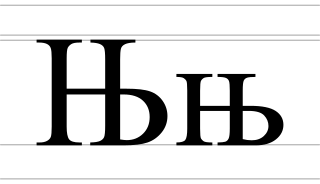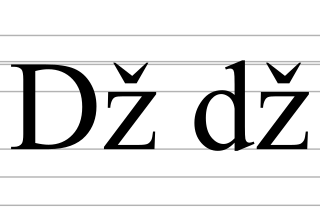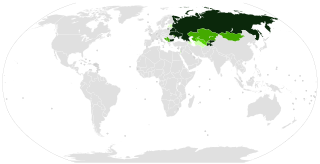
A diacritic is a glyph added to a letter or to a basic glyph. The term derives from the Ancient Greek διακριτικός, from διακρίνω. The word diacritic is a noun, though it is sometimes used in an attributive sense, whereas diacritical is only an adjective. Some diacritics, such as the acute ⟨ó⟩, grave ⟨ò⟩, and circumflex ⟨ô⟩, are often called accents. Diacritics may appear above or below a letter or in some other position such as within the letter or between two letters.

N, or n, is the fourteenth letter of the Latin alphabet, used in the modern English alphabet, the alphabets of other western European languages, and others worldwide. Its name in English is en, plural ens.

A breve is the diacritic mark ◌̆, shaped like the bottom half of a circle. As used in Ancient Greek, it is also called brachy, βραχύ. It resembles the caron but is rounded, in contrast to the angular tip of the caron. In many forms of Latin, ◌̆ is used for a shorter, softer variant of a vowel, such as "Ĭ", where the sound is nearly identical to the English /i/.
A caron is a diacritic mark placed over certain letters in the orthography of some languages, to indicate a change of the related letter's pronunciation.

A digraph or digram is a pair of characters used in the orthography of a language to write either a single phoneme, or a sequence of phonemes that does not correspond to the normal values of the two characters combined.

The grapheme Čč is used in various contexts, usually denoting the voiceless postalveolar affricate consonant like the English ch in the word chocolate. It is represented in Unicode as U+010C and U+010D.

Eng, agma, or engma is a letter of the Latin alphabet, used to represent a voiced velar nasal in the written form of some languages and in the International Phonetic Alphabet.

Nje, or Ñe is a letter of the Cyrillic script.

The grapheme Ž is formed from Latin Z with the addition of caron. It is used in various contexts, usually denoting the voiced postalveolar fricative, the sound of English g in mirage, s in vision, or Portuguese and French j. In the International Phonetic Alphabet this sound is denoted with, but the lowercase ž is used in the Americanist phonetic notation, as well as in the Uralic Phonetic Alphabet. In addition, ž is used as the romanisation of Cyrillic ж in ISO 9 and scientific transliteration.

Dž is the seventh letter of the Gaj's Latin alphabet for Serbo-Croatian, after D and before Đ. It is pronounced. Dž is a digraph that corresponds to the letter Dzhe (Џ/џ) of the Serbian Cyrillic alphabet. It is also the tenth letter of the Slovak alphabet. Although several other languages also use the letter combination DŽ, they treat it as a pair of the letters D and Ž, not as a single distinct letter.

Ń is a letter formed by putting an acute accent over the letter N. In the Belarusian Łacinka alphabet; the alphabets of Apache, Navajo, Polish, Karakalpak, Kashubian, Wymysorys and the Sorbian languages; and the romanization of Khmer and Macedonian, it represents, which is the same as Czech and Slovak ň, Serbo-Croatian and Albanian nj, Spanish and Galician ñ, Italian and French gn, Hungarian and Catalan ny, and Portuguese nh. In Yoruba, it represents a syllabic /n/ with a high tone, and it often connects a pronoun to a verb: for example, when using the pronoun for "I" with the verb for "to eat", the resulting expression is mo ń jeun.
Polish orthography is the system of writing the Polish language. The language is written using the Polish alphabet, which derives from the Latin alphabet, but includes some additional letters with diacritics. The orthography is mostly phonetic, or rather phonemic—the written letters correspond in a consistent manner to the sounds, or rather the phonemes, of spoken Polish. For detailed information about the system of phonemes, see Polish phonology.

En with descender is a letter of the Cyrillic script. Its form is derived from the Cyrillic letter En (Н н) by adding a descender to the right leg.

H with descender is a letter of the Latin alphabet, derived from H with the addition of a small descender. It was used in Uyghur to represent, while a regular H was used to represent.

J, or j, is the tenth letter of the Latin alphabet, used in the modern English alphabet, the alphabets of other western European languages and others worldwide. Its usual name in English is jay, with a now-uncommon variant jy.

En-ge is a letter of the Cyrillic script used only in non-Slavic languages. The shape of the letter originated as a ligature of the Cyrillic letters en and ge, but en-ge is used as a separate letter in alphabets.

Numerous Cyrillic alphabets are based on the Cyrillic script. The early Cyrillic alphabet was developed in the 9th century AD and replaced the earlier Glagolitic script developed by the theologians Cyril and Methodius. It is the basis of alphabets used in various languages, past and present, Slavic origin, and non-Slavic languages influenced by Russian. As of 2011, around 252 million people in Eurasia use it as the official alphabet for their national languages. About half of them are in Russia. Cyrillic is one of the most-used writing systems in the world. The creator is Saint Clement of Ohrid from the Preslav literary school in the First Bulgarian Empire.

Komi Nje is a letter of the Molodtsov alphabet, a variant of Cyrillic. It was used only in the writing of the Komi language in the 1920s.
The Cyrillic script family contains many specially treated two-letter combinations, or digraphs, but few of these are used in Slavic languages. In a few alphabets, trigraphs and even the occasional tetragraph or pentagraph are used.

Ꞑ, ꞑ is a letter of the Latin alphabet, used in several New Turkic alphabet orthographies in 1930s, as well as in the 1990s orthographies invented in attempts to restore the Latin alphabet for the Tatar language and the Chechen language.


















